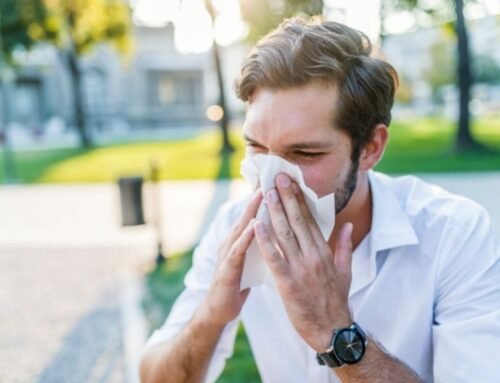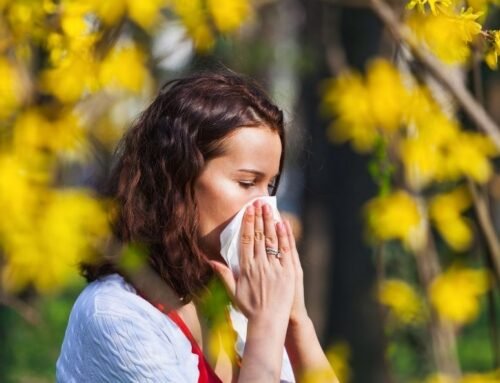Various spices used in our lives have been used by humans for both treatment and flavoring since ancient times. Spices, which are used in very different ways, sometimes appear as the seed or flower of a plant, sometimes as the bark or fruit of a tree, and spice allergy in adults may develop after consumption.
Spices that have been used for many years nowadays are mostly used by South Asians in the world. Spices used in many countries of the world are of course also used in our country. About spice consumption in Turkey is among the countries that use most. Especially in our country, spices play a determining role in the eastern and southeastern Anatolian cuisine culture.
Spices are used not only in meals, but also in toothpastes, perfumes, and cosmetic products.
Spices that we come across in such different ways, “Can it cause allergic complaints? Can it cause an increase in complaints in people with allergies?” leads to questions being asked.
What is Spice Allergy in Adults?
Spices are products that we use many times in our daily lives to give flavor and aroma to our meals. Since the spices we use to add flavor to our meals are made up of plants, they may cause various allergic complaints. Especially in patients with pollen allergy, such as wormwood (Artemisia vulgaris) sensitivity, it is observed that there is also allergy to spices. This type of allergic reaction can occur due to cross reactions between pollen and food.
Many perfumes, shower gels and toothpastes we use in our daily lives benefit from the scents or chemical properties of spices.
Allergic complaints against spices have been reported many times. According to a presentation at the 2012 scientific meeting of the American Society of Allergy Asthma and Immunology (ACAAI), 2% to 3% of the people in the world have an allergic reaction to spices. These allergies may represent 2% of all food allergies, but diagnosis is difficult due to the lack of reliable tests for them. So it can be overlooked. We must remember that allergic reactions can range from sneezing to life-threatening anaphylaxis. In addition, spices used in cosmetics, toothpaste and other dental products in many areas of our lives besides food can trigger our allergies.
If allergic reactions caused by spices occur through inhalation, it may most likely cause runny nose, sneezing, itching, itchy eyes (rhinoconjunctivitis), reactive airway or asthma. When taken with the digestive system, it can cause itching, redness and swelling, ie urticaria, as well as life-threatening anaphylactic shock complaints such as shortness of breath, dizziness, and fainting.
When looking at the reactions that occur with spices, they are generally seen as triggers of allergic reactions, apart from that, reactions mediated by IgE antibodies seen in allergic reactions are much less common.
Prepared Foods
In the ready-made food sector, it is very common to add spices and other accompanying additives into foods. Spices are derived from the flowers or seeds of the plants and therefore potentially allergic. Chemical substances such as tartarazine and glutamate used as food additives can also cause reactions similar to allergic reactions.
Most of the reactions patients have are not real allergic reactions. It can cause non-allergic reactions compatible with food intolerance without causing allergic reactions through antibodies against spices against them. It is extremely important to detect IgE-mediated reactions called early types. It should be kept in mind that life-threatening allergic reactions such as anaphylaxis can be seen with IgE-mediated early type reactions. A non-allergic reaction that is not IgE mediated is likely to be self-limiting.
What are the Spice Allergy Symptoms in Adults?
Nowadays, the spices we use frequently in our meals or in cosmetic products add color to our lives, sometimes with their taste and sometimes with their fragrances.
The spices we use the most; Allspice, Basil, Bay Leaf, Cinnamon, Clove, Cumin Seed, Curry, Dill, Fennel, Ginger, Marjoram, Mustard, Coconut, Thyme, Red Pepper, Parsley, Pepper (black), Pepper (red), Mint, Rosemary, Sage, Thyme can be counted.
There have been many published reactions related to spices, some of which are allergic and some are non-allergic.
The chemicals contained in the spices can cause various reactions in our body. Some of these can bother us a lot, but these responses are non-allergic reactions, more commonly referred to as food intolerance.
Non-Allergic Reactions
Redness on the skin: Spices have properties that can cause irritation and eventually rashes when in contact with the skin.
Example: Cinnamon can cause a local rash when it comes into contact with the skin.
Cough: This type of reaction is likely due to an irritating effect rather than an actual allergy.
For example: Black pepper can cause coughing or trigger asthma symptoms in patients with asthma.
When red hot peppers are eaten, complaints such as hot flashes and diarrhea are related to the chemical substances contained in the chili pepper. Eating hot spices can cause tears in your eyes and burning mouth. The chemicals in these spices (capsaicin and isothiocyanate respectively) irritate the mucous membranes of the nose and mouth. In this case, the effect is physiological and immediate response.
Due to the chemical ingredients in the spices, palpitations, fatigue, red rash seen all over the body may occur in non-allergic ways.
Allergic reactions
Anaphylaxis (allergic shock): Although extremely rare, anaphylaxis has been reported with some spices. Anaphylaxis, which manifests itself with complaints such as shortness of breath, dizziness, itching and redness in the whole body after taking the spices, has been defined with thyme, coriander and cumin.
May cause rhinitis, conjunctivitis, or asthma complaints in patients who are constantly exposed by inhalation.
Some patients with pollen allergy may experience allergic reactions to spices. Oral allergy syndrome, which manifests itself with itching, redness and swelling in the mouth and lips, can be seen especially when spices that cross-react with wormwood and birch tree pollen are taken. Birch pollen and spice syndrome have been shown to be anaphylactic shock.
More frequent anaphylaxis has been described in relation to sesame seeds. Care should be taken as it can be found in many spice mixtures. Since sesame also cross-reacts with some spices with mustard, peanuts and walnuts, these foods should be careful. Patients with known sesame allergies should pay attention to avoid sesame seeds.
When spices come into contact with the skin, it causes allergic contact dermatitis, which develops with a late type allergic reaction. Contact dermatitis due to spices can be seen in herbalists or cooks, especially in people who have a lot of contact with spices. Allergic contact dermatitis has been reported following contact with cinnamon. Some spices that cause the development of allergic contact dermatitis can cause systemic allergic contact dermatitis, which can be more serious when they pass through the digestive system. Spice-containing toothpaste, perfume or other cosmetic products cause allergic reactions.
How is Spice Allergy Diagnosed?
If a spice allergy is suspected, it is appropriate to see an allergist. Spice allergy can manifest itself with different symptoms. Therefore, it would be appropriate to take a detailed history by the allergist and to make the diagnosis by performing the necessary tests.
To diagnose spice allergy, allergy skin test (prick test) can be performed. The skin prick test, which we use to diagnose pollen allergy and food allergy, can be used to diagnose spice allergy, but skin tests may not be sufficient to make a correct diagnosis, especially in spices containing hot. Positive and correct results can be obtained in skin prick tests used in the diagnosis of spices other than hot spices.
It is made with the Prick to prick technique using fresh spices or extracts, and the seasoning that causes an allergic reaction can be detected. Since these tests are risky, it would be appropriate to be done by allergy specialists.
Apart from skin tests, blood allergy tests may also be necessary to diagnose spice allergy. Checking for specific IgE specific to food, which is thought to cause spice allergy, may be useful for diagnosis. However, a sufficient number of spices may not be detected as most commercial kits are only used to test a small variety of spices.
Apart from this, in order to reveal the relationship between the spices themselves or the pollens, allergen component tests from the blood as well as the skin tests can detect allergens that cause allergies, as well as common allergens of pollen and spices that cause allergies.
For tests used in the diagnosis of food allergies, basophil activation tests and food challenging tests are less frequently used. Especially food provocation tests should be done under the supervision of allergists.
Patch testing is used to show late-type allergic reactions. Patch tests are used to diagnose contact dermatitis caused by spices. In particular, it should be kept in mind that cosmetic products such as toothpaste, creams, shower gels or perfumes may cause allergic contact dermatitis, except for those who are professionally exposed to herbalists or spices. The positivity of the patch tests was mostly detected with ginger, coconut and thyme.
Patch testing can be done with an extract prepared in appropriate concentrations for the suspected spice. It is important to note that the spice itself can cause irritation. However, not all spices can be tested this way.
Given these challenges, personal experience and assistance from an allergist are often invaluable in making a diagnosis.
How to Treat Spice Allergy in Adults?
Once diagnosed, the treatment of spice allergy depends largely on the type and severity of symptoms.
As with food allergies, the current approach to treating spice allergy is based on preventing the allergen and treating allergic reactions promptly, preventing reactions that may be more serious. The most important of all is the education of the patient.
Until the specific spice causing the allergy is determined, the patient should avoid the suspicious spice and may need to use medication for complaints. Especially, patients at risk of anaphylactic shock should have an epinephrine auto-injector with them that can be injected by themselves.
If the spice that causes spice allergy is detected, it should definitely be prevented from using it. He should know that he should be careful about packaged foods and be very careful while eating at restaurants. She should be educated to read food labels, as well as to be cautious about potential food, as these effects may not be complete.
Drug treatment is recommended when allergic spices are taken and complaints occur.
For an uncomplicated allergy, oral antihistamines may be used. It can provide relief by suppressing the histamine activity released by the immune system that triggers allergy symptoms.
For allergic contact dermatitis that occurs after contact with spices, creams containing a topical corticosteroid can help reduce redness.
Oral corticosteroids should be used in more extreme cases.
People at risk of anaphylaxis should carry the epinephrine auto-injector with them.
Cross-reaction is extremely important in spice allergies, some pollen or foods. Some patients with pollen allergy have been shown to develop allergies to foods, especially spices. In particular, allergens that cross-react between pollen and spices may lose their allergenic properties at high temperatures. Therefore, cooking, baking can protect against spice allergies, but some allergens may increase their allergenic properties with heat.
Allergy vaccine (immunotherapy), which is effectively applied against pollen, may also be effective on spice allergy associated with pollen, but there is not enough information on this subject.
As a result
We use spices many times in our daily lives to add flavor and aroma to our food, but spices can cause allergic reactions like other herbs.
Allergic reactions caused by spices; It can range from itching, redness and swelling in the body, ie urticaria, to life-threatening anaphylactic shock such as shortness of breath, dizziness and fainting. It can also cause late-type allergic reactions and cause allergic contact dermatitis.
Between 2% and 3% of the people in the world have an allergic reaction to spices. These allergies can represent 2% of all food allergies.
It has been observed that many reactions have been published regarding the spices. Some of these are allergic and some are non-allergic reactions. Most of the reactions patients have are not real allergic reactions.
Chemical substances contained in spices can cause various reactions in our body. Some of these can disturb us a lot, but these non-allergic reactions are more commonly referred to as food intolerance.
In order to diagnose spice allergy, the allergy skin test (prick test) can be performed first. In addition, an accurate diagnosis can be made by blood allergy tests, patch test and oral provocation tests.
As with food allergies, the current approach to treating spice allergy is based on allergen prevention and prompt treatment of allergic reactions.
People at risk of anaphylaxis should carry an epinephrine auto-injector with it.
Spice allergy is extremely difficult to diagnose. Therefore, it is extremely important to evaluate the patients that the tests are performed by allergists.
Important information:
Pediatric Allergy Specialists (Pediatric Immunology and Allergy Diseases Specialist) are doctors who have received special training in asthma and allergic diseases seen from birth to 18 years of age, and are also Pediatric Immunology and Allergy Specialists diplomas.






